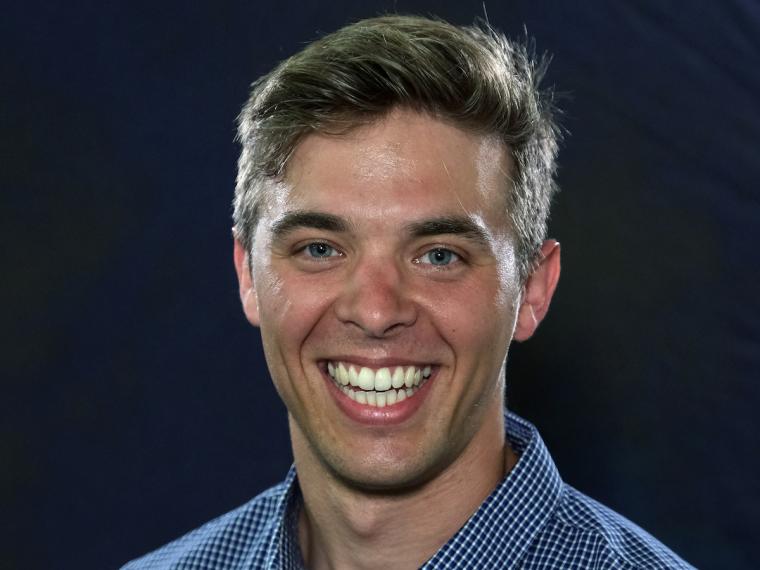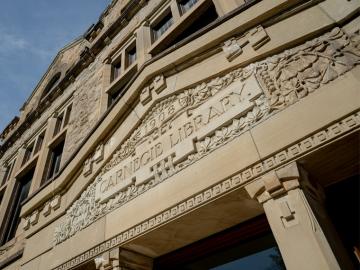All About Balance
July 31, 2023
Tyler Applegate

Christopher Ayoub got his first taste of research in the biology labs of Oberlin. By the summer after his sophomore year, he had secured an internship researching circadian rhythms at the University of Texas Health Science Center. The following summer, he was investigating bone formation at Washington University in St. Louis.
Each time, he returned to Oberlin to push his research further under the guidance of biology professor Maureen Peters. Their work together led directly to Ayoub’s first job after graduation: as a research technician at Baylor College of Medicine.
Today the 2015 grad from Houston, who completed Oberlin majors in anthropology and biology, is pursuing two more degrees that span both disciplines: a PhD and MD at Ohio State University.
We caught up with Ayoub to learn more about his journey since Oberlin.
You pursued two majors at Oberlin and were a varsity athlete on the swimming and diving team. What was it like balancing all of that?
Balance is the key word. Each one of those gave me a break from the others, such that doing all of those things helped me not to get burned out. I was also in the College Choir, which added a little music to the mix too!
I actually came to Oberlin with no clue what major I wanted to pursue. I created a giant spreadsheet every time class registration came around because I wanted to make sure I kept my options open. Over the course of several semesters, I realized I loved biology—thank you, [Emeritus Professor] Yolanda Cruz—and I wanted to balance the natural science with a social science. I had narrowed it down to English and anthropology, but Introduction to Linguistic Anthropology with Professor Erika Hoffmann-Dilloway really drew me in—not to mention Human Origins with Professor Amy Margaris, which merged the two subjects! Then there was swimming, which gave me an escape from academics, alternative goals to focus on, exercise for endorphins, and a team that was my family away from home. The swim team was a vital support system for me to maintain my sanity and to find joy at Oberlin.
What inspired you to pursue a career in medical research?
As I was figuring out what to do with a biology major or an anthropology major, I knew a lot of peers who had research positions. Molecular biology was particularly captivating to me because many of its techniques, like PCR [polymerase chain reaction] and Western blotting, elegantly take advantage of naturally occurring biological mechanisms. While I was at UT Health, my first research mentor, Dr. Seung-Hee Yoo, was also the first to suggest the double-major pathway to me.
As this simmered at the back of my mind, I began to think of it as a way to continue both of my majors. There were 13 programs around the country that would allow me to continue anthropology as a PhD and biology as an MD. However, I was doing more biology research at Oberlin with Professor Peters and more the next summer at Washington University, and I realized that I love biology research, which would not be continued through a PhD in anthropology. I also realized that the MD could just as easily be the extension of my anthropology major, as I would be working with patients and other medical professionals from all walks of life.
With that perspective in mind, I started to see how the two degrees would work together—where medicine informs the gaps in understanding and care that need to be addressed through research, and where research inspires changes that advance the standard of care. Pursuing medicine and research together constantly keeps the other in perspective. For me, it’s very motivating to know that my research has the potential to have a real impact on people’s lives by improving health outcomes. Good health is fundamental to so much of our lives.
What sort of research did you do at Oberlin?
In Maureen Peters’ lab, I studied the defecation motor program in C elegans [a type of roundworm], a tightly controlled, repetitive behavior that occurs roughly every 50 seconds. More specifically, I was part of investigating the permissive conditions that allow the expulsion contraction to take place at the end of every 50 seconds. The independence and freedom Professor Peters gave me to follow my observations really allowed me to develop my scientific curiosity. The technical skills she taught me in handling worms also helped me snag my first job after Oberlin, where I was a research technician in a C elegans microbiome lab at Baylor College of Medicine.
The hallmark of an Oberlin education is an open-ended, lifelong curiosity and passion for learning that will be fundamental to my success as a physician-scientist.”
Did others at Oberlin help shape your career goals?
I had so many wonderful mentors at Oberlin. Maureen Peters was my research advisor, but she has been so much more than that to me. She also taught me genetics—one of the most elegant and inspiring fields of research, which certainly primed me for a PhD project in bioinformatics. She wrote letters of recommendation that helped me get into my dual-degree program. Professor Peters also advised our chapter of Colleges Against Cancer, for which I was treasurer, helping us brainstorm and plan engaging programs that would reach as many students as possible. Above all, Maureen Peters has been a role model for the relationships I want to build with future trainees and for the work-life balance I want to achieve, where I prioritize my family as well as my work.
I also had several other mentors in biology, anthropology, and on the swimming and diving coaching staff whom I owe many thanks.
What sort of work are you doing at Ohio State?
I’m a student in the Medical Scientist Training Program. I recently completed my PhD work in [biochemistry], studying gene expression in the context of Alzheimer's disease tauopathy [neurodegenerative disorder], and now I am returning to the clinical years of medical school.
How might your research affect our understanding of Alzheimer’s disease?
I think the main contribution of my first author paper is that it provides a new approach for dissecting gene expression according to the differential vulnerability of different brain regions to tauopathy. In doing so, we see that some aspects of the brain’s response to Alzheimer’s are shared between regions, and other aspects are unique to each brain region. This provides insight into what biological processes promote vulnerability and what processes promote resistance to Alzheimer’s tauopathy and degeneration. These are all potential targets for future study and development of disease-modifying therapies, which remain elusive for Alzheimer’s and other neurodegenerative tauopathies.
What comes next after your PhD and MD?
Next up will be medical residency! As I return to medical school, I am keeping an open mind as to what specialty to pursue; however, as I begin to look into residency programs, I am certainly interested in those that incorporate time for research. My end goal for all of this training is to become a physician-scientist, balancing research and clinical practice. I like to think that this path has all been an extension of my double major at Oberlin, where the PhD research has been a continuation of my biology major, and medicine will be a continuation of my anthropology major as I engage patients and other medical professionals from all walks of life. The hallmark of an Oberlin education is an open-ended, lifelong curiosity and passion for learning that will be fundamental to success as a physician-scientist.
Tags:
You may also like…
Oberlin Provides Foundation for Future Education
April 29, 2025
While Oberlin on its own is a singular and enriching experience, it is also an excellent stepping stone for future education. Sherry Miao ’23, who majored in economics here at Oberlin, is currently pursuing her master’s in public policy at the Harvard Kennedy School (of Harvard University).
Knocking it out of the park
April 28, 2025
From studying economics to coaching in MLB, Max Anastasio is paving his way with perseverance.
Five Oberlin Alumni Earn 2025 Guggenheim Fellowships
April 25, 2025
Five Oberlin alumni have been awarded prestigious Guggenheim Fellowships.


